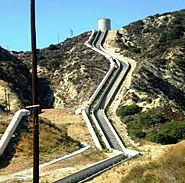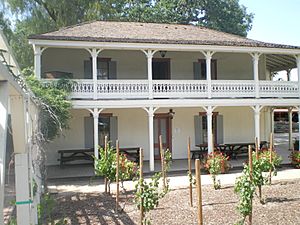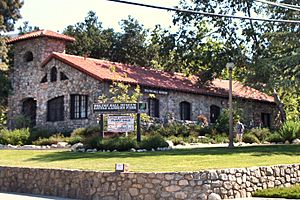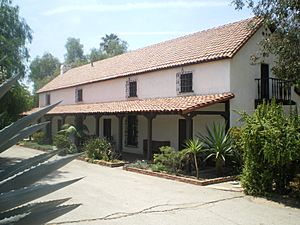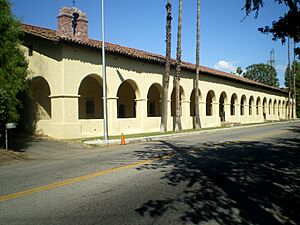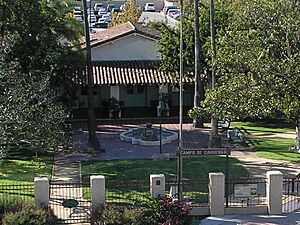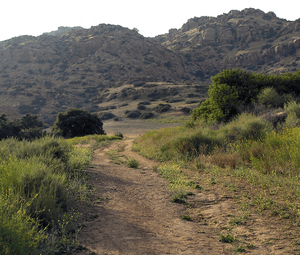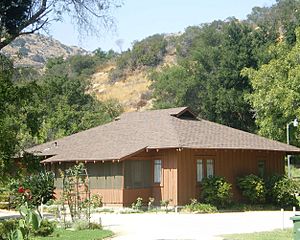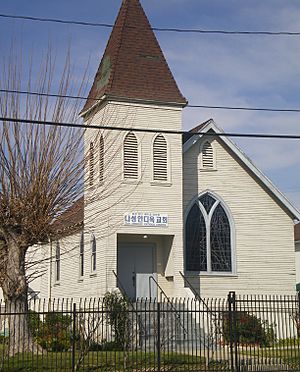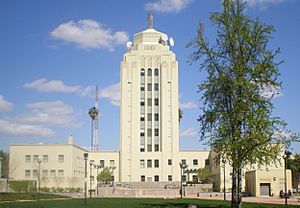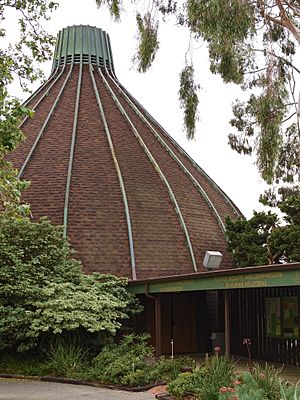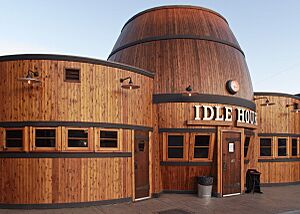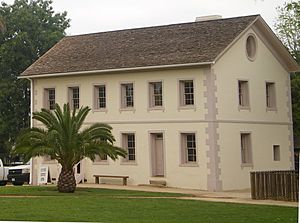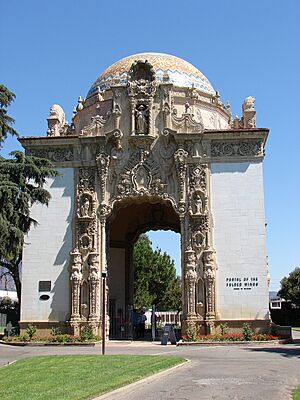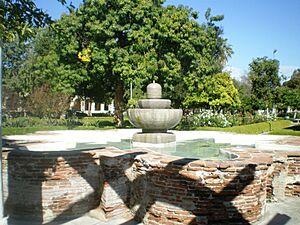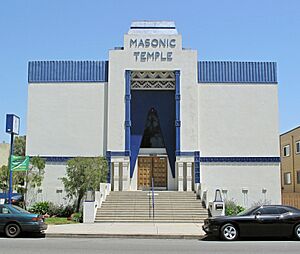List of Los Angeles Historic-Cultural Monuments in the San Fernando Valley facts for kids
Los Angeles is a city full of amazing history, and some of its most special places are called Historic-Cultural Monuments (HCMs). These are buildings, sites, or even trees that are important because of their history, art, or culture. Think of them as official treasures that the city wants to protect and remember!
This list focuses on the HCMs found in the San Fernando Valley and the nearby Crescenta Valley. There are more than 70 of these special spots in these areas. Some of them are also recognized by the state of California or even the whole country as California Historical Landmarks or places on the National Register of Historic Places.
Contents
- Discovering the Valley's Historic Treasures
- Some Notable Historic-Cultural Monuments
- Leonis Adobe (HCM #1)
- Bolton Hall (HCM #2)
- Rómulo Pico Adobe (HCM #7)
- Mission San Fernando Rey de España (HCM #23)
- Encino Oak Tree (HCM #24)
- Campo de Cahuenga (HCM #29)
- 114 Deodar Trees (HCM #41)
- 76 Mature Olive Trees (HCM #49)
- Old Stage Coach Trail Property (HCM #92)
- Minnie Hill Palmer House (HCM #133)
- Chatsworth Reservoir Kiln Site (HCM #141)
- Faith Bible Church (HCM #152)
- Valley Municipal Building (Van Nuys City Hall) (HCM #202)
- Amelia Earhart Branch (North Hollywood Branch Library) (HCM #302)
- El Portal Theater (HCM #573)
- San Fernando Pioneer Memorial Cemetery (HCM #586)
- Sepulveda Unitarian Universalist Society Sanctuary ("The Onion") (HCM #975)
- Idle Hour Café (HCM #977)
- Other Important Historic Sites
- See also
Discovering the Valley's Historic Treasures
The Historic-Cultural Monuments in the San Fernando Valley are spread out all over the place! You can find them from Chatsworth in the northwest to Studio City in the southeast. They also stretch from the city of Calabasas in the southwest to Tujunga and La Crescenta in the northeast.
When Los Angeles first started choosing these special monuments in 1962, the very first two chosen were in the San Fernando/Crescenta Valleys! They were HCM #1, the Leonis Adobe, and HCM #2, Bolton Hall.
The oldest building in the Valley is the Convento Building at the Mission San Fernando Rey de España. It was built a long, long time ago, between 1808 and 1822. Other places connected to the Mission San Fernando include a kiln (a type of oven) in Chatsworth used to make bricks and tiles for the mission, and the wells and settling basin in Sylmar that supplied water to the mission. The Pioneer Cemetery is also important, as it's where both Mission Indians and early Valley settlers are buried.
Besides the Mission, two old adobe (mud-brick) buildings are among the oldest in the Valley: the Rómulo Pico Adobe, built in 1834, and the Leonis Adobe, built in the 1840s.
Many of these monuments are also listed on the National Register of Historic Places, which means they are important to the history of the entire United States. Some examples include the Leonis Adobe, Bolton Hall, Rómulo Pico Adobe, the Convento Building, and Campo de Cahuenga.
Churches and other places of worship are also on the list, like the Chatsworth Community Church (from 1903), Faith Bible Church in Northridge (from 1917), and the Saint Saviour's Chapel in Studio City. The David Familian Chapel of Temple Adat Ari El in North Hollywood was the Valley's first Jewish synagogue.
Even trees can be monuments! The city has honored a 1,000-year-old oak tree in Encino (which was sadly removed in 1996), 114 Himalayan Deodar trees along White Oak in Granada Hills, and 76 olive trees along Lassen Street in Chatsworth. There are also 300 pepper trees lining Canoga Avenue in Woodland Hills. These trees tell a story about how the Valley grew and changed over time.
Some Notable Historic-Cultural Monuments
Here are a few examples of the many interesting Historic-Cultural Monuments in the San Fernando Valley:
Leonis Adobe (HCM #1)
This beautiful adobe house was built in the 1840s. It was home to Miguel Leonis, a very important person in early Los Angeles history. Today, it's a museum where you can learn about life in the old days. It's located in Calabasas, near Woodland Hills.
Bolton Hall (HCM #2)
Built in 1913, Bolton Hall is a community building made from local stones and materials. It was part of a special community in Tujunga that had a unique vision for living together. The City of Los Angeles now owns it, and it's open to the public.
Rómulo Pico Adobe (HCM #7)
This two-story adobe house was built in 1834 and is the oldest home in the San Fernando Valley! It's now run by the San Fernando Valley Historical Society in Mission Hills.
Mission San Fernando Rey de España (HCM #23)
This Spanish mission was built in the late 1700s. The Convento Building, shown in the picture, was rebuilt after an earthquake in 1971. It's the 17th California Mission and a very important historical site in Mission Hills.
Encino Oak Tree (HCM #24)
This amazing oak tree in Encino was thought to be 1,000 years old! Sadly, the tree was damaged and removed in 1997, but its memory lives on as a monument.
Campo de Cahuenga (HCM #29)
This site in Studio City is where the Treaty of Cahuenga was signed on January 13, 1847. This treaty officially ended the Mexican-American War in California.
114 Deodar Trees (HCM #41)
These beautiful Cedrus deodara trees, originally from the Himalayas, were planted in 1932 in Granada Hills. They line White Oak Avenue and are a lovely natural monument.
76 Mature Olive Trees (HCM #49)
These olive trees were planted in the late 1800s and line both sides of Lassen Street in Chatsworth. They are a living reminder of the Valley's agricultural past.
Old Stage Coach Trail Property (HCM #92)
This historic trail in Chatsworth dates back to the 1860s. It was once a stagecoach road that connected the San Fernando Valley to other areas like Simi Valley and Ventura, crossing the Santa Susana Pass.
Minnie Hill Palmer House (HCM #133)
This charming cottage was built in 1913 in Chatsworth. It's a great example of the homes built by the first settlers, called homesteaders, in the San Fernando Valley.
Chatsworth Reservoir Kiln Site (HCM #141)
Known as La Calera, this site in West Hills has the remains of a kiln. This kiln was used to make bricks and tiles for the San Fernando Mission a long time ago. It's fenced off, so you can't visit it directly.
Faith Bible Church (HCM #152)
Built in 1917, this was the very first church in Northridge. It was originally called the Norwegian Lutheran Church and has a beautiful Gothic style.
Valley Municipal Building (Van Nuys City Hall) (HCM #202)
This important building in Van Nuys was constructed in 1932. It's designed in the Art Deco style and is one of the most recognized landmarks in the Valley.
Amelia Earhart Branch (North Hollywood Branch Library) (HCM #302)
This library in North Hollywood was built in 1929 in the Spanish Colonial Revival style. It's named after the famous aviator Amelia Earhart, who lived in North Hollywood.
El Portal Theater (HCM #573)
Located in North Hollywood, this theater, office, and retail building was completed in 1926. It's a great example of Spanish Renaissance Revival architecture.
San Fernando Pioneer Memorial Cemetery (HCM #586)
This cemetery in Sylmar is the second oldest in the San Fernando Valley. It's the resting place for early pioneers, Civil War veterans, and Mission Indians.
Sepulveda Unitarian Universalist Society Sanctuary ("The Onion") (HCM #975)
Built in 1964 in North Hills, this modern-style church sanctuary is nicknamed "The Onion" because of its unique shape. It was designed by a student of the famous architect Richard Neutra.
Idle Hour Café (HCM #977)
Constructed in 1941 in North Hollywood, this building is shaped like a giant barrel! It's one of the last remaining examples of "Programmatic design" from the early 20th century, where buildings were shaped like the things they sold.
Other Important Historic Sites
Besides the Historic-Cultural Monuments, there are other special places in the Valley recognized by the state and nation:
Los Encinos State Historic Park
This park in Encino was once a ranch. Franciscan padres (priests) used it as their base when they were exploring the valley before they built Mission San Fernando in 1797.
Portal of the Folded Wings Shrine to Aviation & Museum
Located in North Hollywood, this is a memorial to the brave pioneers of aviation. It's a special place to remember those who helped us take to the skies.
Brand Park (Memory Garden)
These beautiful gardens in Mission Hills were once part of the Mission San Fernando. Now, they are a public park where people can relax and enjoy nature.
Phil's Diner
This classic diner was built in the 1920s. It was moved and reopened in 2008 in North Hollywood, right across from the El Portal Theater. It's a fun example of old-school American diners.
Masonic Temple (North Hollywood, California)
This unique building in North Hollywood is a Masonic Temple. It was designed by architect Robert Stacy-Judd and has a cool Mayan-style look.
Griffith Ranch
This ranch, located in Sylmar and San Fernando, was bought by the famous filmmaker D.W. Griffith in 1912. Many classic Western movies, including The Birth of a Nation, were filmed here! You can find a historic marker at Foothill Blvd. and Vaughn St.
See also
Lists of L.A. Historic-Cultural Monuments
- Historic-Cultural Monuments in Downtown Los Angeles
- Historic-Cultural Monuments on the East and Northeast Sides
- Historic-Cultural Monuments in the Harbor area
- Historic-Cultural Monuments in Hollywood
- Historic-Cultural Monuments in Silver Lake, Angelino Heights, and Echo Park
- Historic-Cultural Monuments in South Los Angeles
- Historic-Cultural Monuments on the Westside
- Historic-Cultural Monuments in the Wilshire and Westlake areas
Other
- City of Los Angeles' Historic Preservation Overlay Zones
- National Register of Historic Places listings in Los Angeles
- National Register of Historic Places listings in Los Angeles County
- List of California Historical Landmarks


